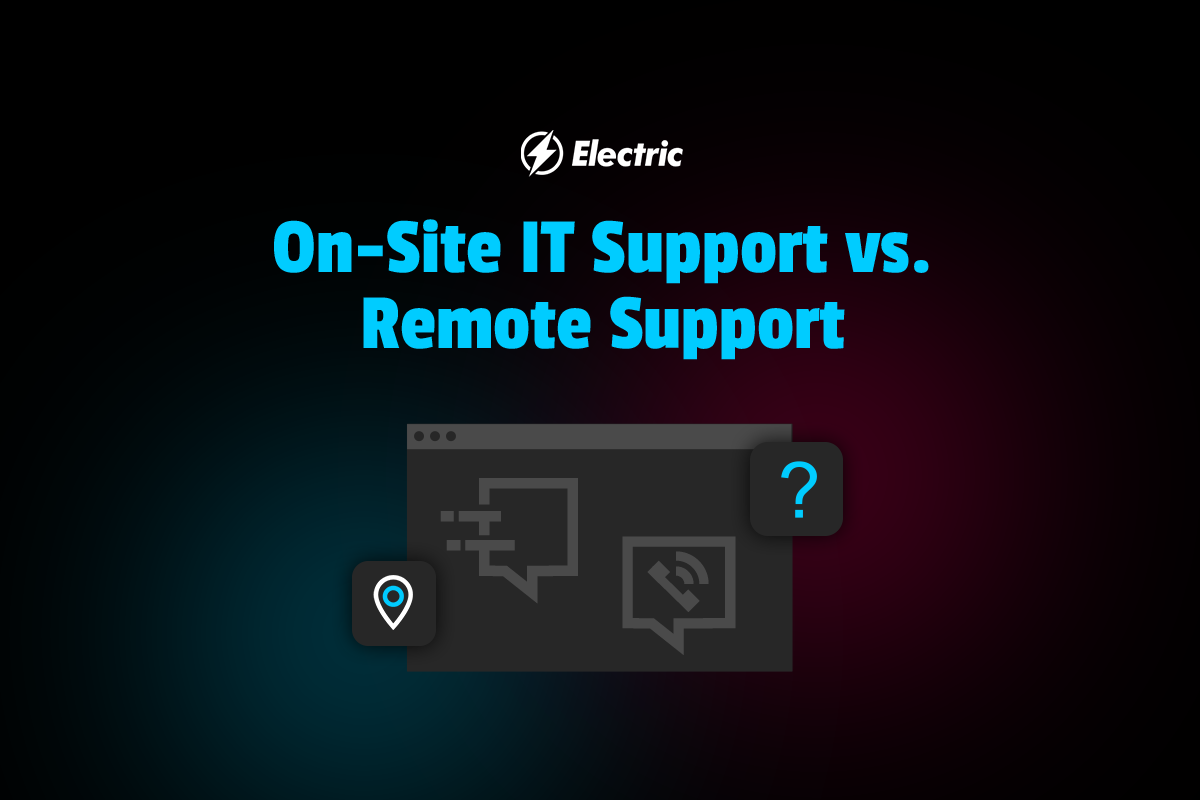
As a small-to-medium sized business, you likely rely on technology to perform almost all of your day-to-day operations. As a result, you have to grapple with the reality of bugs, corrupted files, licensing issues, security risks, and all the other challenges that come with IT. Having a high standard of IT support that focuses on finding solutions for these issues is crucial.
While having on-site IT support can often seem like the best option to solve a lot of these problems, in-house teams can struggle with downtime and other distractions. This can lead to employees being left waiting for a response, and lost productivity until their issue is addressed. This wait time becomes even longer when the problem occurs outside business hours.
If you’re currently encountering these challenges, you may be considering remote IT support for your SMB, which involves outsourcing IT management to a Managed Service Provider (MSP). While remote IT support offers a host of advantages, business leaders can find themselves weighing up these benefits against having an on-site IT team. To help you reach the best decision for your business, this article breaks down both concepts and provides the pros and cons of each.
On Site IT Support vs. Remote IT Support
Although it’s pretty self explanatory, the main difference between on site IT support and remote IT support is simply where the team is located. On site support will come into your office or is already within your office and will help you in-person, while remote IT support can help you from anywhere as their services are digital.
How Does On-Site IT Support Work?
On-site IT support usually translates to a dedicated IT professional (or team of professionals) employed directly by your company, working from an office location. They offer IT support to your employees, work with you one-on-one, and will likely be embedded into the organization’s structure.
Having an on-site specialist who you can interact with face-to-face can offer business leaders a sense of security and consistency. Being able to ask questions and have last-minute issues addressed may seem like it is only achievable through on-site IT support, although this isn’t necessarily always the case.
How Does Remote IT Support Work?
Remote IT support involves allowing a managed service provider to control IT tools from a location outside your business premises. The MSP provides tech support over high-speed connections and can usually relay solutions over the phone, through email, or via live chat.
These external technicians will need to have remote access to your IT infrastructure through advanced solutions. Oftentimes, basic remote support is incident-based, although many MSPs also offer more strategic services as well as ongoing monitoring and support.
Pros and Cons of On-Site IT Support
When it comes to on-site IT support, you essentially have IT professionals integrated into your business. As a result, these professionals can end up with a greater understanding of the business, which could help with running the IT infrastructure as efficiently as possible.
An additional advantage is that it becomes possible to foster a relationship with your IT team, which can be leveraged in the future. Specifically, working with the same team over long periods translates to these individuals having a greater grasp of your systems and setups, as well as your business goals and metrics of success.
On the other hand, having on-site IT support has a few downsides. For starters, it can be almost impossible for these professionals to get everything done within the available resources of an SMB, as they will likely end up bogged down by day-to-day IT needs. This can leave no room for creative technology solutions that would see greater innovation and growth.
An additional disadvantage of having an on-site support team is that the business can end up with a star IT team member who has access to all its critical information and infrastructure. The impact of this is increased key-person risk. IT professionals are in high demand, and employee turnover can have serious consequences.
Finally, depending exclusively on the on-site team can be challenging when the IT issue is beyond the scope of the experts at hand.
Pros of On-Site IT Support
- In-person relationship building
- Business knowledge and experience
Cons of On-Site IT Support
- Risk of turnover, lost knowledge
- Inability to keep up with demand
- Stifled innovation, limited expertise
Pros and Cons of Remote IT Support
The first advantage of outsourcing your IT support is that you gain access to experts that know their stuff, having amassed knowledge through working with diverse companies. MSPs will often have a large pool of experts with a wide range of expertise that an on-site team might not be able to replicate.
When you partner with a seasoned MSP, they will also offer you strategies to manage your IT infrastructure and optimize existing practices. Moreover, remote IT support experts could be instrumental in boosting your bottom line. Your business benefits from having a team of senior-IT experts without having to pay each a salary. The alternative is an on-site team that requires competitive wages and benefits, and the in-house cost of device procurement, training, and career development.
Finally, with remote IT support, you can ensure round-the-clock availability of professionals to resolve out-of-hours issues. Overall, by bringing an MSP on board as a partner, you effectively take care of some of the bottlenecks that on-site IT experts might not sufficiently cater to.
While this solution provides quite a number of perks, there can be some downsides to having remote IT support. SMBs must do their research when selecting an MSP to avoid potential issues such as inflexible contracts, additional charges for certain services, slow response times, or an overall lack of visibility.
Pros of Remote IT Support
- Access to expert knowledge and high-standards of support
- Strategic insights to optimize existing IT infrastructure and practices
- Cost savings and consistency of service
- Out-of-hours support
Cons of Remote IT Support
- Rigid contracts and/or unforeseen costs
- Lack of visibility
- Slow response times, depending on provider
On-Site IT Support vs. Remote Support: Which is Best?
As your SMB grows, it’s natural for your IT demands to increase too. As such, outsourcing IT support to an MSP can be the best choice for businesses as they scale. SMBs already have to grapple with the challenges of having a small team – removing IT support from your plate means you can focus on core processes and leave IT issues to the experts. Moreover, having remote IT support means you can be confident in security patches, firewalls, intrusion detection, and any other problems that might come up within your IT infrastructure. For a managed service provider you can rely on to deliver rapid responses, customized support, and full visibility into your IT, contact Electric today.



